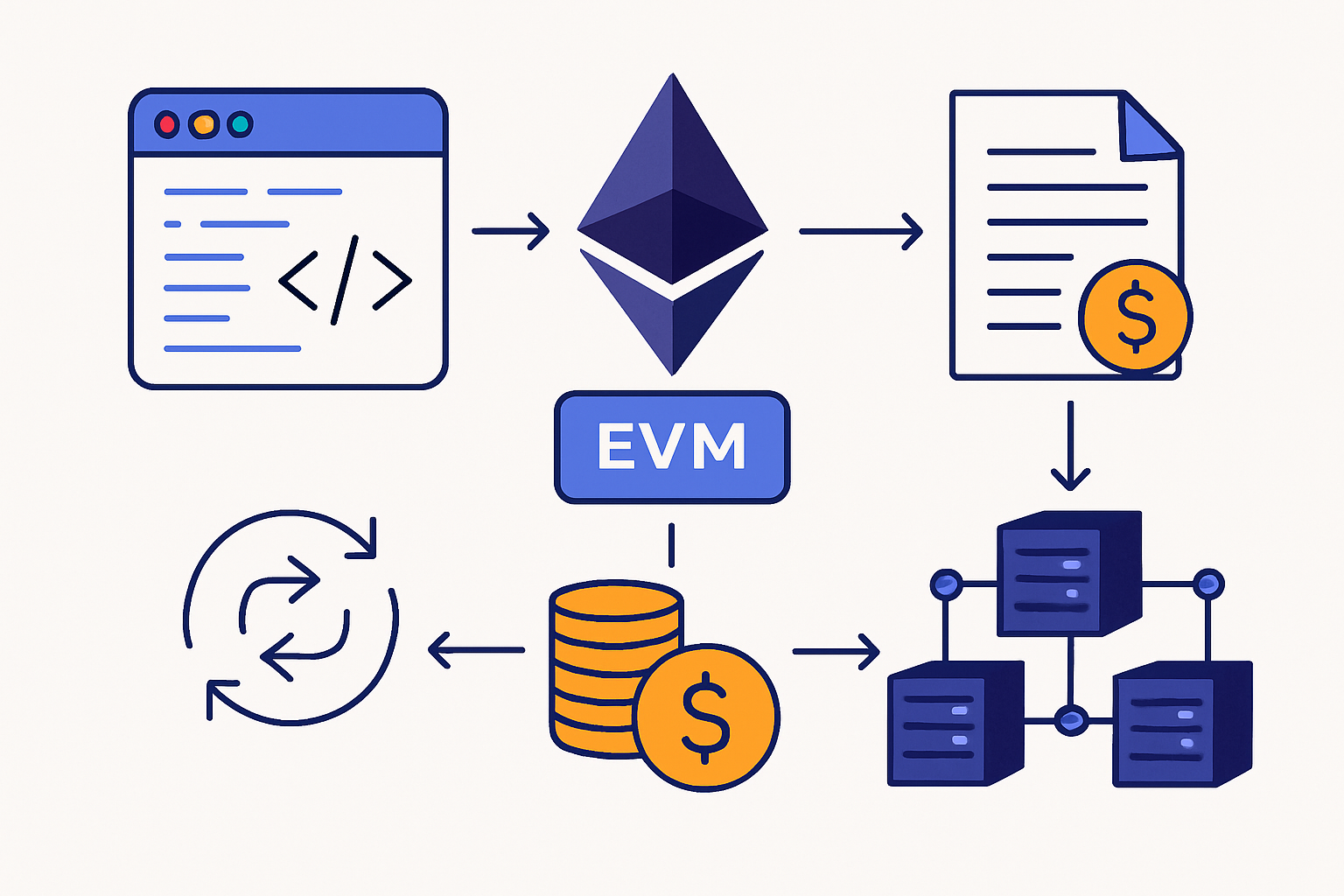How Smart Contract Works on Ethereum and Other Chains


Smart contracts are agreements that pretty much run themselves, automatically enforcing their terms without the need for any middlemen meddling in the process. They are a big deal in the world of blockchain because they bring transparency and a level of trust that doesn’t rely on any single party. Ethereum really put smart contracts on the map, giving developers the power to craft decentralized applications (dApps) that keep chugging along all on their own.
Smart contracts are built on blockchain technology, which acts like a decentralized ledger shared across countless participants around the globe. Thanks to features like decentralization, there is no single point of control or failure lurking around the corner. Immutability is another handy trick up its sleeve, ensuring data stays put once it is recorded—no sneaky edits allowed. Meanwhile, consensus mechanisms make sure everyone’s on the same page when it comes to the network’s transactions. All these principles working in harmony help smart contracts run smoothly and transparently, without leaning on a central authority.
What Exactly Are Smart Contracts?
A smart contract is essentially a piece of code tucked away on a blockchain that springs into action automatically when certain conditions are met. Unlike regular contracts that usually require someone to enforce them, smart contracts act independently and are built to resist any funny business.
They tend to pop up quite a bit in industries like finance for decentralized lending and real estate where they help manage property transfers. They also appear in supply chains to keep tabs on goods and in gaming for handling in-game assets and rewards we all love to collect.
Understanding How Smart Contracts Function on Ethereum A Closer Look
An Ethereum smart contract takes a bit of a journey through a few key stages. It’s penned down in Solidity, which is kind of like the language of choice here. Next up, this code gets compiled into bytecode—think of it as translating your recipe into a secret code only the Ethereum kitchen understands. Then comes the big moment: deployment onto the Ethereum blockchain, where it’s officially live and kicking.
Write your smart contract in Solidity, Ethereum's very own language tailor-made for handling contract logic with finesse.
Compile your Solidity code into Ethereum bytecode using handy tools like Remix or Hardhat. You will find these pretty straightforward once you get the hang of them.
Deploy your compiled contract to the Ethereum blockchain through a wallet such as MetaMask, but keep a close eye on those gas fees because they can sneak up on you.
After deployment, you’re all set to call functions on the contract by sending transactions that actually trigger its logic. It is kind of like pressing the 'start' button.
Keep an eye on managing state changes and any events the contract emits. All of this is double-checked and stored permanently by the network, so there’s no need to worry about losing track.
The Ethereum Virtual Machine (EVM) acts as the trusty runtime environment for smart contracts, running their bytecode reliably across every single node. This rock-solid consistency means everyone ends up with the exact same result when executing contract code.

Gas is basically the fee you need to fork over to get transactions done and smart contracts running on Ethereum. Think of it as a tip for miners or validators who do the heavy lifting—handling computations and making sure the whole network stays secure. This clever setup helps keep resource misuse in check by slapping a price tag on every little operation.
How Smart Contracts Really Work Across Various Blockchain Platforms
Besides Ethereum you have platforms like Binance Smart Chain, Solana, Polkadot and Cardano stepping up with their own smart contract capabilities. Each plays their cards differently using a mix of programming languages, consensus methods and scalability tricks that over time tend to click with different developer preferences and project needs.
| Blockchain Platform | Programming Language | Consensus Mechanism | Transaction Speed | Gas Fees |
|---|---|---|---|---|
| Ethereum | Solidity | Proof of Stake (PoS) | Around 30 transactions per second, which is decent but can feel a bit slow during peak times | Moderate to high |
| Binance Smart Chain | Solidity | Delegated Proof of Stake (DPoS) | Roughly 100 transactions per second, offering a nice balance of speed and efficiency | Low |
| Solana | Rust, C, C++ | Proof of History combined with PoS | Approximately 65,000 transactions per second—yes, you read that right, blazing fast! | Very low |
| Polkadot | Rust, Ink!, Solidity (via parachains) | Nominated Proof of Stake (NPoS) | Around 1,000 transactions per second, though it varies depending on the parachain in play | Moderate |
| Cardano | Plutus (based on Haskell) | Ouroboros Proof of Stake | Close to 250 transactions per second, quietly impressive without the fuss | Low to moderate |
Each platform’s unique quirks steer how developers build and roll out smart contracts. Take Solana for example. Its blazing high throughput and wallet-friendly fees make it a natural fit for microtransactions and gaming where speed and cost matter. On the flip side, Polkadot’s interoperable parachains are like the social butterflies of blockchains. They effortlessly support cross-chain dApps that mingle across ecosystems. Then there’s Cardano which marches to the beat of its own drum by zeroing in on formal verification to crank up security. This feature really speaks to industries where getting things right is not just preferred but downright essential.
Practical Guide on Creating and Deploying a Smart Contract
Ready to roll up your sleeves? This guide walks you through the nuts and bolts of crafting and launching a smart contract—no fluff, just the essentials you’ll want to know before diving in.
Start by setting up your development environment with Node.js and choose a framework that suits your style like Hardhat or Truffle.
Dive into writing your smart contract in Solidity using a comfortable IDE such as Remix or Visual Studio Code because having the right tools makes all the difference.
Compile your contract to catch pesky syntax errors early and to generate the ABI and bytecode. It is a bit like proofreading before sending an important email.
Connect to an Ethereum testnet like Goerli using MetaMask to safely test your deployment without real funds. Think of it as a dress rehearsal.
Deploy your contract on the testnet and keep a close eye on the transaction status. A bit of patience here goes a long way.
Finally, interact with your contract's functions through scripts, a user interface or Remix to ensure everything works just as you intended. There is nothing like the satisfaction of a smooth run!
Some popular tools for smart contract development include Remix IDE, a friendly choice especially for beginners looking for a straightforward online way to write and test code without much fuss. Then you have Truffle and Hardhat, both packing powerful local development and testing environments that seasoned devs tend to swear by. And MetaMask is pretty much the go-to for managing Ethereum accounts and sending transactions with a few clicks.
Handy Tips and Tried-and-True Practices for Navigating Smart Contracts Safely
- Be sure to thoroughly test your smart contracts with unit tests and testnets. Catching bugs early can save you a real headache down the line.
- It’s wise to get professional security audits done to sniff out vulnerabilities like reentrancy or integer overflows that might otherwise slip through the cracks.
- Try to optimize your contract code to trim down gas costs, but don’t sacrifice readability or functionality. In my experience, clarity pays off in the long run.
- Always keep your private keys under tight lock and key. Never ever expose them in your code or any online repositories where curious eyes could find them.
- Stick to keeping your contracts simple and modular because it makes maintenance a breeze and lets you upgrade things smoothly when the need arises.
Smart contract developers often face pitfalls like reentrancy attacks where a malicious contract repeatedly pokes vulnerable functions to steal funds. Another headache is keeping gas fees under control by carefully streamlining contract logic and using loops cautiously. Handling upgradeability can feel like walking on thin ice since once contracts are deployed they’re set in stone and usually require wrapper or proxy patterns to enable improvements.
Deploying a smart contract without a careful security audit is a bit like leaving your front door wide open in a sketchy neighborhood. Trust me, putting security front and center is absolutely key if you want to keep both your assets and your users out of harm's way.





